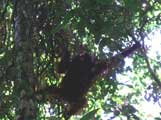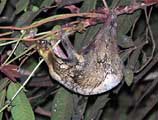Sounds of the rainforest of Borneo
Aug.29,2007. M.Sekine
"Wha, wha, wha, wawawawawa..." The calls of Mueller's gibbon
which is indigenous to Borneo break through the raucous morning noises of
dense rainforests. Gibbons are vociferous animals, particularly at sunrise
and sunset. Their calls can carry more than a mile. I am now in a tropical
rainforest, not like Japan's forests at all. A hornbill, with a wingspan
of about one meter, is flapping away. I look up at the sky in spite of myself
at the flap of the bird's wings. Wow, hornbills are really beautiful birds.
I happened to come across an old male orangutan; I estimate the age
to be about forty. As 'the man of the forest' moved from tree to tree, so
did the trees tremble more. As the orangutan rambled in the leafy canopy
of the rainforest, so did the branches snap. The branches fell to the ground.
It was the first time I had ever seen a wild orangutan from such a close
distance, so I could not press down the shutter of my camera because I was
so excited. It was so impressive. The orangutan snapped a thick bough and
threw it away on the ground. The orangutan seemed to be disgusted at my
following him.
In the next morning, I came across a mother orangutan. She was gnawing
at the seeds of plants of the pod-bearing legume family on a tree. Bean
pods fluttered to the ground. At the same time, cicadas began to sing.
As shown above, the rainforest of Borneo contains many forms of life,
so you hear a great variety of sounds there.
But meanwhile, a silence fell over the forest. In the quiet of the starry
night, in the repose of the forest, a mother flying lemur was hanging from
a bough.
Wonderful Borneo! The rainforest is filled with the sounds of the wildlife.
I certainly enjoyed and experienced the nature of the rainforests of Borneo
first hand.
Click on the icon to get more than 70 photos of the wildlife of Borneo with Japanese descriptions and English captions.
| Photos of the wildlife of Borneo |



